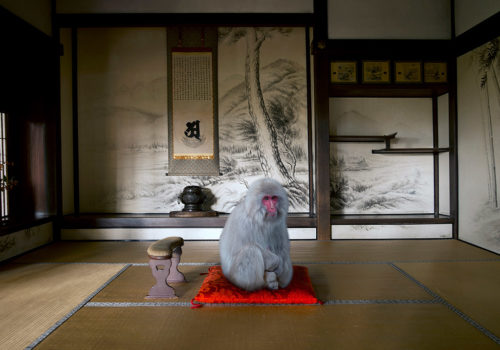Since 2012, Karen Knorr has been exploring and learning about Japanese heritage culture travelling to Tokyo, Kyoto, Nara and Ise several times during different periods of the year. She continues to travel there in order to capture the transience of the seasons which are viewed through the structures of temples and shrines. After the 2011 Tohoko earthquake and tsunami which killed over 15000 people in Japan, Knorr felt compelled to visit Japan out of friendship and a deep feeling of sympathy. She has been working on two series which complement each other yet use distinct approaches: Karyukai focuses on portraiture with waka (poetry) composed by the sitters and Monogatari places animals and people on architectural sites which serve as witnesses of an ancestral legacy that still pervades Japanese life today.
Karyukai is a series of portraits of women in traditional kimono dress created in collaboration with artists, models and friends. They refer to ukiyo-e (japanese term meaning « pictures of the floating world ») representing bijin-ga (pictures of beauties) which are found in Japanese screens and prints. The photographs are accompanied by haikus composed by the women sitters and printed on to the surface of the portraits similar to the temple prints of poets that Karen Knorr found in the Blue Lotus temple in Kyoto.
These portraits allude to the remnants of Geisha culture in contemporary Japanese life.
The geisha figure – gei meaning art and sha meaning the person practising this art – along with Mount Fuji have been symbols of Japan ever since the Meiji era, when Japan opened to west culture in the mid-19th century. In recent decades, geishas have been working more openly outside of their usual structures. Indeed, geishas usually live in a matriarchal society in the hanamachi (geisha quarters) in Kyoto, Osaka and Tokyo. Geisha still undergo a strict training earning their living by entertaining male business clients with music, conversation and dance.
Although today Japanese women wear western clothes, kimonos are still worn for special occasions such as the coming of age ceremonies (1) and family reunions. The type of sleeves and obi (2) are important as are colours and designs that signify status and whether the woman is married or not. For example, furisode (3) kimonos with long swinging sleeves are worn by unmarried women and tomesode (4) kimonos are worn by married women.
Monogatari, a new series following from Fables (2004-2008) and India Song (2008-2010) in its methodology considering animal life and cultural heritage this new series refers to Japanese heritage and myth. Animals appear on elegant architectures that Knorr has discovered in the Tale of Genji, famous modern novel written by Murasaki Shikibu, a courtesan from the Heian era, over the course of the 10th century. These temples are still visible throughout Kyoto and a lot of them contain gorgeous golden screens painted by the famous Kanō school of painters.
This work also refers to the popular tale’s fantastic world. Animals look like yōkai, ghosts and supernatural monsters which belong to folklore. They may possess animal like features or othertimes they can appear mostly human or take the shape of an inanimate object. Women wearing kimonos, who sometimes accompany them in the Karen Knorr’s stagings, corroborate the omnipresence of the tradition.
(1) Coming of Age Day (seijin shiki) is a holiday celebrated in order to congratulate and encourage all those who have reached the age of 20.
(2) An obi is a sash for traditional Japanese dress, keikogi worn for Japanese martial arts, and part of kimono outfits.
(3) The furisode (litteraly « swinging sleeves ») is the most formal type of kimono.
(4) The tomesode is a type of kimono with shorter sleeved than furisode.
EXHIBITION
Monogatari
Karen Knorr
From October 29th to November 28th, 2015
Galerie Les filles du calvaire
17 rue des Filles-du-Calvaire
75003 Paris
France
http://www.fillesducalvaire.com
karenknorr.com
















